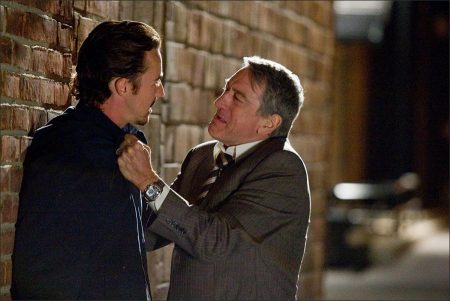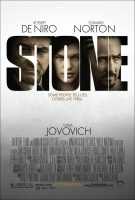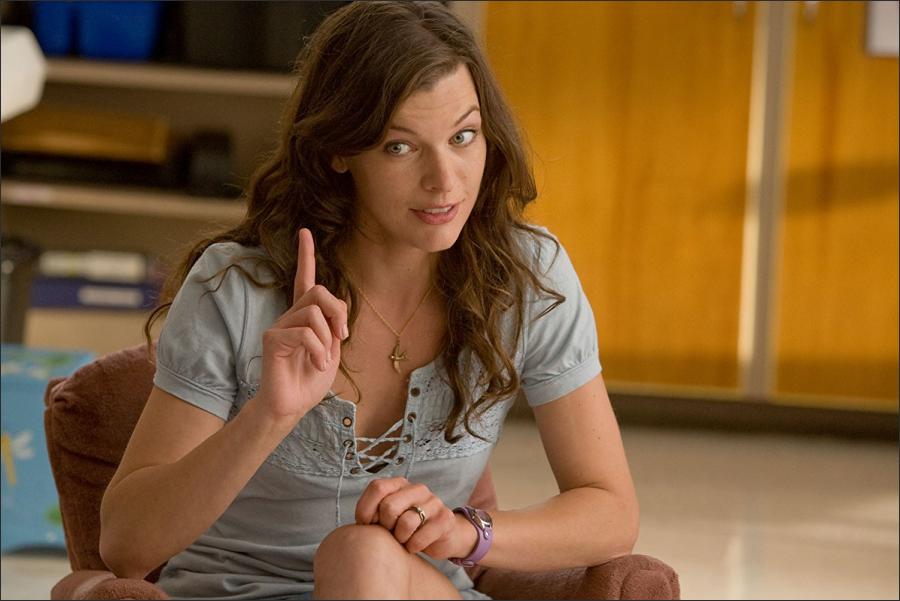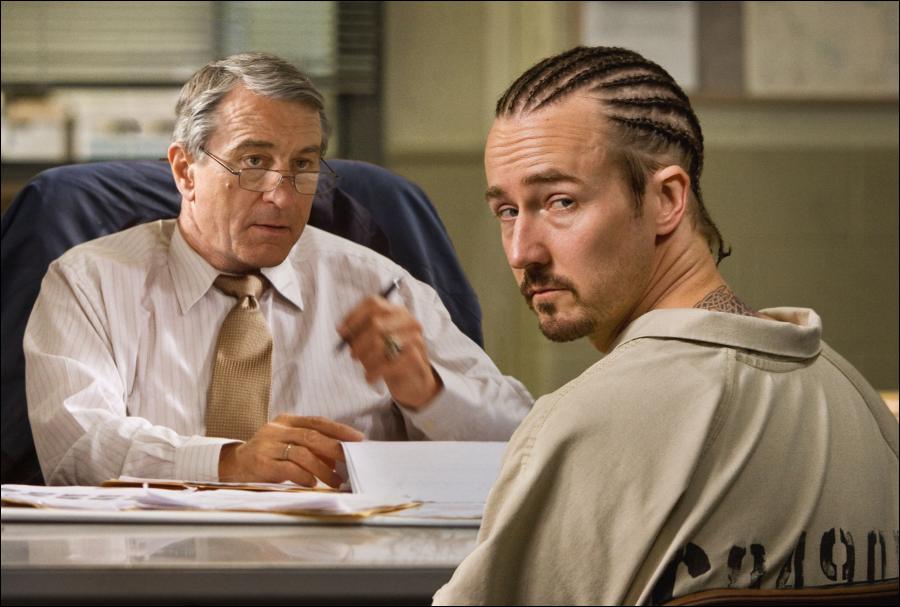The Four Sides of the Story
A true ensemble production, Stone gives each of its four stars the chance to explore a rich and layered character, full of contradictions and surprises. “The characters were what made us want to make Stone,” says producer Holly Wiersma. “They are all sympathetic, but they’re all very flawed. You’re always trying to figure them out.” The first to commit to the project was legendary leading man Robert De Niro. With two Oscars to his name, the first for his breakthrough role in The Godfather Part II and the second for playing boxer Jake La Motta in Martin Scorsese’s Raging Bull, De Niro has delivered some of the finest performances in modern American cinema.
De Niro’s Jack Mabry is a conflicted character, a man whose actions are at odds with his words. “Jack does some despicable things,” says Wiersma. “But he also needs to be someone people feel they know and like. Without someone accessible playing that role, it becomes much harder to watch. We knew that Bob would bring a certain amount of sympathy to it. Jack’s a charming man, but he does not do charming things in this picture.”
John Curran was happy to let the legendary actor take the lead when it came to defining the character. “De Niro is a hero of mine,” says Curran. “The desire to work with him was a big part of what brought me to the table. Bob was keen to find an authentic hook to his character—but his process is very intuitive and private. Mostly I got out of the way. I wanted to mold Jack around Bob’s idea of him, not mine.”
The character’s dilemma struck De Niro as a timeless, larger-than-life predicament. “Jack’s facing a classic, biblical sort of temptation,” he says. “He and his wife have been together for many years, but they don’t really talk, they just exist together. When the siren is put in front of him, it becomes a morality tale of sorts. He holds a position of moral authority, but he has all these other feelings.”
He was also interested in exploring the evolving dynamic between Stone and Jack. “They each represent something totally different,” he says. “Stone is a manipulator. He’s using Lucetta to compromise Jack and influence his recommendation regarding Stone’s release. At the same time, Stone has found some new religion, almost randomly, in the prison library. Suddenly, he doesn’t care whether he’s out or in, and that complicates the whole thing. As they both start moving toward the middle, Stone calls Jack on a lot of things and expresses some basic truths. He gets under Jack’s skin.”
It takes a confident actor to convincingly get the best of De Niro and Norton is up to the task. “Edward Norton is one of the few actors around that can believably terrorize Bob De Niro,” says Wiersma. “You just know Jack’s met his match when Stone walks into the room. You never know where Stone’s coming from. You don’t know if he’s playing you or what his ulterior motives are.”
While working together on The Score, a stylish, fast-paced heist film in 2002, De Niro and Norton developed a rapport that helped establish their relationship in this film.” They came to the set as friends with a great respect for each other,” says the director. “In almost all their scenes together, they’re sitting in chairs on either side of a desk speaking pages of dialogue with no rehearsal. That could’ve been terrifying, but there was already a trust and understanding between them before we started that informed all their interactions.”
Norton and John Curran had developed a good creative relationship working on The Painted Veil, which Curran directed and Norton starred in and produced. “We’re both pretty frank, but we also remain open to being proven wrong,” says the director. “The benefit the second time around was familiarity. It allowed for a shorthand of communication and process. We agreed early on that Stone Creeson would be unlike any character Edward had played before.”
Drawing on the film’s setting for inspiration, the pair began fleshing out a disturbing and disturbed character. “We always felt that Stone should come from the margins,” says Norton. “He has never had even rudimentary training in how to be a stable person or any kind of guidance into spiritual life. He is a person who has fallen through the cracks and he’s as far from someone who’s likely to have a profound spiritual transformation as anyone you’ll ever encounter. And yet, by the end of the film, he’s actually gone through the biggest transformation. He and Jack have almost inverted their existential states.”
Playing opposite De Niro for a second time, Norton is still awed by his co-star’s talent. “So many young actors dream of making a film with Bob,” says Norton. “For me, this was the experience I fantasized about. It is a monumental performance. It’s a naked portrayal of this person entrenched in emotional denial and on a collision course with his shadow side. I found it unsettling and disturbing, as well as remarkably nuanced and insightful.”
“Bob’s work over the years has included some of the deepest investigations of dysfunction and loss in American cinema,” says Norton. “So many of his best performances are about peering under the hood of the American dream. He’s explored themes like rage and fame and some of the more corrosive effects of American life more deeply than anyone else I can think of.”
Each of the four main characters in Stone drives the action at some point, but it is Lucetta, Stone’s wife, who sets off the bitter rivalry between the two men with her incendiary sexuality. Lucetta is a creature of contradictions, ethereal and earthy at the same time. “John always described her as the naughty girl in school who never escaped the town,” says Wiersma.
The paradoxes of the character made the casting tricky, as did Lucetta’s passionate relationship with Stone. “She had to be beautiful,” says Norton. “Lucetta has such visceral impact on people and she’s very sensual. But it couldn’t be someone who was put together in a way that would make you think, ‘Why would she ever be with this guy?’ You have to believe that they could come from the same world.”
After headlining three installments in the futuristic action franchise Resident Evil, Milla Jovovich was eager to take on a role that would allow audiences to see her in a different light. Lucetta’s complexities and contradictions provided exactly the sort of challenge the actress was looking for. “On the one hand, she’s an innocent,” says Jovovich. “On the other, she’s very sexual. Put these two elements together and you get a really wild character who’s living life every day to its fullest. In contrast to these two men who are always thinking, she doesn’t think, she just does.
“Lucetta’s relationship with Stone is very passionate,” continues Jovovich. “He’s in control, but at the same time he’s been in prison for eight years, so she’s had to make her own way. She’s trying to get her husband out of prison, but once he goes through his spiritual experience, she doesn’t recognize the man that she fell in love with. The man she worked so hard to get out is not the man that comes out in the end.”
Jovovich’s unique blend of innocence and sophistication captivated the filmmakers at her first audition for the role,” says Wiersma. “She can be as playful and fun as any teenager one moment, and then, in a flash, demonstrate the maturity of a grown woman.”
Curran was impressed by the supermodel-turned-actress’ nonchalant attitude about her looks. “Milla made me laugh in her audition,” he says. “More than anyone we saw, she understood the contradictions in Lucetta and had the most fun teasing out every side of her.”
Her unconventional approach reminded Norton of some of his favorite actresses. “Milla makes me think of actresses that I really love from the ’60s and ’70s, like Sandy Dennis or Karen Black, actresses who were gorgeous but not at all square,” he says. “She straddled the difficult demands of this part perfectly. There are kinks in what she does that make it original and unusual. As Stone says, Lucetta’s an alien from another planet. She does things that seem completely contradictory. Milla manages to hold it all together in an integrated package.”
Her character’s easy sexuality did not come easily to Jovovich. “I have some crazy scenes in this movie,” she reveals. “As an actor, you often walk in shoes that you would never wear otherwise, and it can be difficult, especially in a movie like this where I had multiple sex scenes with different men. At times, I found myself really upset by the end of the day. John gave me so much support and that was very important to me. When you’re putting yourself out there as a woman, in the way that I do in this movie, it’s so important to trust that the director really knows what he wants and knows how he’s going to cut it together in the end so it’s never gratuitous and the nuances remain intact.”
Her dedication did not go unnoticed by her co-workers. “Milla had a very difficult task in creating this character,” says De Niro. “And she really did a great job. She totally committed.”
The caliber of her co-stars also saw her through some of her more difficult moments. “Working with Edward Norton and Robert De Niro was just one of the most incredible experiences I’ve ever had,” she says. “They put so much passion into their work. Edward is a highly intelligent, highly articulate, and very generous person. Robert is an icon and an amazing actor, but he’s also a very sweet family-oriented guy.”
Frances Conroy, best known as Ruth Fisher from the HBO series “Six Feet Under,” faced a different kind of challenge playing Madylyn, Jack’s neglected wife. In contrast to Lucetta’s flamboyant sensuality, Madylyn is a pious and deeply emotional woman of very few words. “Frances embodies a specific kind of innocence and real humanity,” says Schur. “She presents this character on equal footing with the other characters. It’s an incredible achievement.”
Jack and Madylyn Mabry are a middle-aged couple who, in some respects at least, are not unlike thousands of others. A lifelong homemaker, Madylyn has made religion the central point in her life. Jack attends church with her, but lacks the same profound faith that she has. “Like Madylyn, Frances is naturally gentle and very sweet,” says Curran. “She really delivers on her character’s piousness. But what really blew me away were her instincts for Madylyn’s darker turns.”
Like De Niro, Conroy was drawn to the complex truths that simmer just below the surface of the characters. “Stone is a thought-provoking story,” says Conroy. “It’s very intimate and quite explosive, physically as well as emotionally. And Madylyn is such an interesting character. She opens up gradually in little haikus. John said that we were going to discover Madylyn as we went along and she is very subtly unveiled.”
While Conroy has appeared in films alongside an army of Oscar winners including Cate Blanchett, Daniel Day-Lewis, Meryl Streep, Nicolas Cage, Dustin Hoffman and Tom Hanks, working with Robert De Niro was still a thrill for the actress. “It was very special to play his wife,” she says. “He’s a very private person and an extremely focused actor who saves his energy for the moment action is called. Working with him is filled with the lovely silence of someone who is completely present.”
The long-married Mabrys have spent decades ignoring the subtle, ongoing disintegration of their relationship. “Jack and Madylyn’s marriage is devoid of intimacy,” says Conroy. “Two people existing in the same house, but living in separate universes within themselves. It is a marriage between two estranged partners, ripe for the violent changes that occur in the story.
“The events of Stone have a profound effect on their relationship, but the cracks are already showing,” Conroy continues. “They have their evening drink together, but they don’t really talk that much. Jack is ripe for a transition; Madylyn can see that. And so they are completely present as they lose one another. It’s quite moving and true to life.”
In fact, the actress reflects, each of the four major characters in Stone is facing life-changing events. “These people go through a big journey. You have to wonder how they’re all going to come out of it. It’s not an easy ending, but it gives you a lot to think about and I think people will be really touched.”
The Crumbling Heartland
Screenwriter Angus MacLachlan originally set Stone in his native North Carolina, as he had his first film, Junebug. When John Curran signed on as director, he urged MacLachlan to relocate the action to the heart of the American Rust Belt, the area around Detroit, Michigan. “John was really drawn to the landscape of abandonment there,” says Edward Norton. “There’s the sense that you have arrived in purgatory.”
Financially troubled for decades, Detroit and the surrounding area were devastated by the economic downturn, turning into an urban and exurban wasteland. The filmmakers arrived in Detroit shortly after Barack Obama became president and approved the bailout of the automobile industry. “It was strange and sad time to be in Michigan,” says Curran. “Detroit was a city in a state of crisis. As backdrop to the story of Jack’s moral decay, it provides an authentic sense of a specific period in time. It felt right to try to infuse the story with sense of what was going on at the time.”
Like many who have recently visited there, Norton was shocked by the state of the city. Detroit has had one of the highest rates of real estate foreclosures in the country, leaving some neighborhoods virtually empty. “There is an incredible sensation that it is reverting to nature in some places,” Norton says. “And it’s not just poor areas. People have walked away from middle and upper class neighborhoods on a scale that’s hard to believe.
“We wanted Stone as much as possible to be a product of that environment of urban abandonment,” he continues. “When we were at the prison, I tried to meet with inmates who specifically came out of the tougher neighborhoods in Detroit about their experiences.”
Stone’s prison sequences were shot at the Southern Michigan Correctional Facility in Jackson, Michigan, which provided a realistic venue for many of the scenes— as well as the germ of an idea for a possible future MacLachlan screenplay. “It’s a gigantic prison built in the late ’20s or early ’30s, and it still has the cells with open bars,” says MacLachlan. “Parts of it are still an active prison, and we filmed in the portions of it no longer in use. The fact that there were still actual prisoners there caused some confusion, though. We had a group of extras wearing the orange prison outfits. The guards came and grabbed one of them thinking he might be someone trying to get out— which I think is a great jumping off point for a movie.”
In addition to the obvious advantage of ready-made sets, Curran discovered some unexpected benefits to shooting in the prison. “More than anything, there was an odd palette of color throughout that I could never have conjured from scratch,”’ he says. “The people there were fantastic and extremely helpful. In addition to enduring all the technical and procedural questions we hammered them with, they gave Edward and me access to the prisoners for interviews.”
As an actor, Norton says he is constantly searching for insight into the reality of his characters’ situations, and he found inspiration for Stone in the prisoners he met in Michigan. “I was looking for a voice and a look and real language,” he says “I found people who represented aspects of what I thought Stone’s experience might have been and spent time getting to know them. We even showed them parts of the script and asked for their help in kind of making it more realistic. A lot of what I brought to the character of Stone came out of what we found in those guys.” Norton also adopted physical quirks like the cornrows of one prisoner for his character, as well as absorbing the atmosphere around him.
De Niro spent time on the other side of the bars, as well, to learn the ins and outs of his character’s job. “Bob worked with one of the top prison officials, someone who does in real life what Bob’s character does in the film,” says Schur. He was on set everyday to offer his insights.”
The story’s other main setting, Jack and Madylyn Mabry’s home, is far from both the prison and the urban chaos of Detroit, but it represents another, more personal side of the disintegration of the American heartland. The filmmakers selected a small farmhouse dating back to the 1840s to create a sense of isolation and claustrophobia that Frances Conroy saw as a metaphor for the Mabrys’ marriage.
“The house has small rooms and a very steep staircase that’s enclosed,” she says. “You can bump into one another pretty easily. Sometimes that’s not so good in a marriage. It doesn’t let you get away quite as much as you might need to.”
Everything about the house speaks of age and stasis. “The same things have been hanging on the walls for years,” says Conroy. “The furniture bespeaks a life lived with not too many changes. You see Madylyn vacuuming and even the vacuum’s been around for a long time. The house is out in a field and there’s a barn behind it. There aren’t any neighbors nearby. It’s solitary, but not necessarily peaceful, a brooding house in a way. It needs some help, just as its inhabitants do.”
For MacLachlan, the settings are just one aspect of the enormous collaborative process that he has encountered in his first foray as a writer outside of the independent film world. “People talk about how artistic projects have a life of their own,” he says. “There came a point for me when I had to let go and say now it’s all of our project… it’s everybody’s project.”
Stone (2010)
Directed by: John Curran
Starring: Robert De Niro, Edward Norton, Milla Jovovich, Frances Conroy, Enver Gjokaj, Pepper Binkley, Rachel Loiselle, Sandra Love Aldridge, Kylie Tarnopol, Sarab Kamoo, Bailey Tarnopol
Screenplay by: Angus MacLachlan
Production Design by: Tim Grimes
Cinematography by: Maryse Alberti
Film Editing by: Alexandre de Franceschi
Costume Design by: Victoria Farrell
Set Decoration by: James V. Kent
Art Direction by: Kerry Sanders
MPAA Rating: R for strong sexuality and violence, and pervasive language.
Distributed by: Overture Films, Relativity Media
Release Date: October 8, 2010










